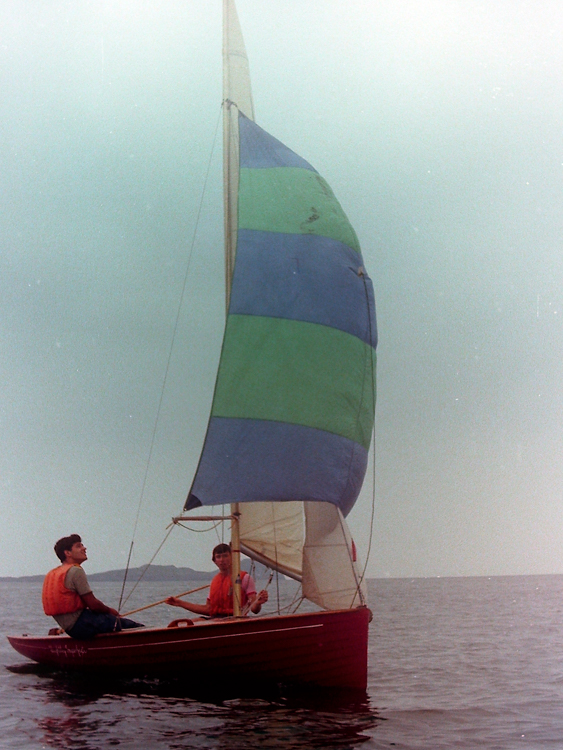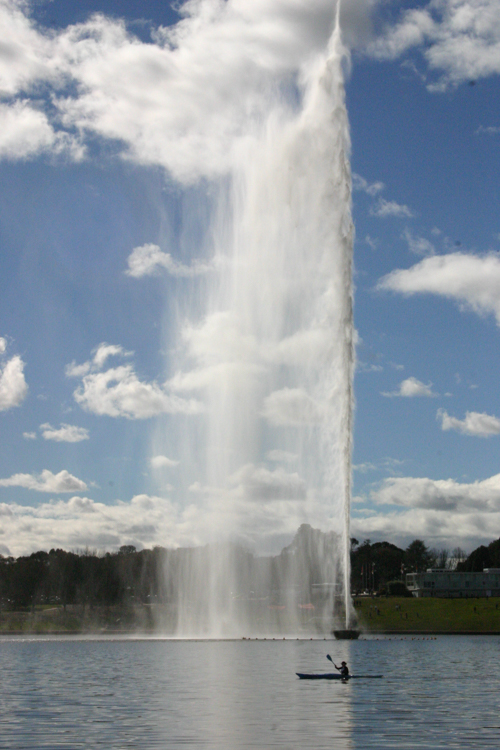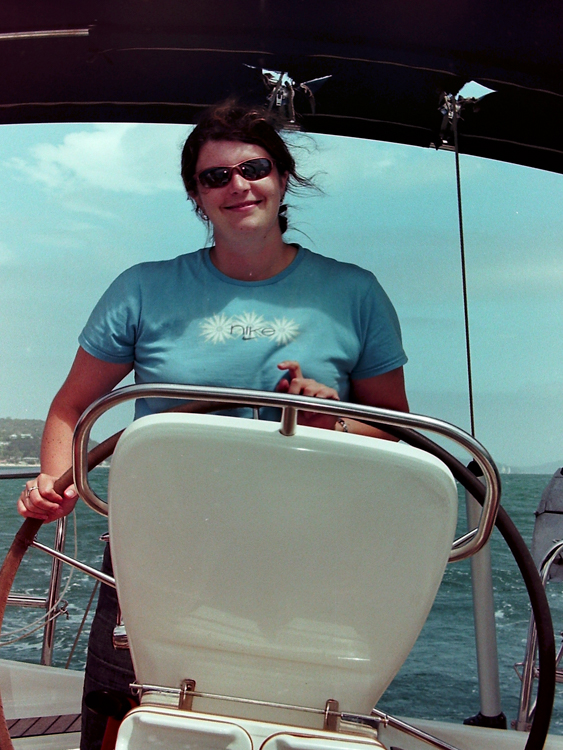The Germ of an Idea
Way back before we were married, before we were even an item, Bronwyn and I were sitting in a bar somewhere idly discussing what it was that we wanted to do with our lives. We were both in good jobs and had, individually, achieved our childhood ambitions, including travelling around the world. We’d both left our native countries in the northern hemisphere, and were, at least temporarily, living in Australia. We had well-paid and flexible jobs that meant that we could go round the world as often as we liked, but it was somehow all too easy. Life consisted of hard work and fine dining, extreme sports and luxurious living. All perfect, but it was beginning to feel a bit hollow, so what next?
Somehow or other, out of the blue, one or the other of us came up with the idea of sailing around the world. This was almost completely ridiculous, as neither of us knew how to sail. But if it was something new and difficult that we were after, then this would certainly be a challenge. After a while, the conversation bogged down in our complete lack of knowledge or experience of things nautical, and we ordered some more beer and turned our attention to other topics.
The next day, unbeknownst to Bronwyn, I contacted my old mate David, who had been sailing small boats since we were boys, and asked his opinion on the practicality of buying a yacht and sailing around the world. Bear in mind that I hadn’t the faintest idea of what a yacht cost or how long it took to cross an ocean, nothing at all.
David was stunned. As a small boy, I once crewed on his racing dinghy in the Thames, showing no aptitude whatsoever.

Andrew and David crew “Slightly Imperfect” 1982
To his credit, and after only a few stunned expostulations, David settled down and answered the questions. It turned out that I had hit pay dirt; he had once intended to go voyaging with his entire family, and still had the file containing all his research, in which he evaluated types of vessel, running costs, equipment and all the multitudinous host of other things that I had, until then, no idea that I had to consider. I added up some numbers on the back of an envelope, and emailed Bronwyn at her work, pointing out that it was, at least financially, feasible.
Things moved on. Bronwyn thought about my crazy plan, and suggested that, in actual fact, she would consider sailing around the world with me. One thought evidently led to another, and, some time later but back in that same bar where the crazy idea had started (for the record: The Phoenix, Canberra), she got down on her knees in the spilled beer and cigarette butts and proposed marriage.
Distinguishing the pointy end from the flat end
While planning the wedding, we looked into the little matter of learning to sail. Canberra, where we were living, is capital of a landlocked desert state several hours from the nearest coastline. The only water is in the artificial lake in the centre of the city. This happens to be the home of the Canberra Yacht Club, where for a small fee you can hire a dinghy or even enter your own (necessarily small – the lake is not very deep!) trailer yacht in the weekly twilight race. There is also a sailing school, which teaches you how to handle a dinghy. It turned out that, in a previous life, Bronwyn had done a little dinghy-racing in Lasers, and had in fact the previous year taken a refresher dinghy-sailing course at the Canberra Yacht Club. She had a word with Matt, who runs the course, and suddenly I was enrolled.
The course took me from “this is a mast, this is a sail” through to rigging a dinghy, and then off we went onto the water. Over the weeks of the course there was in fact very little wind, so we spent quite a lot of time circling the Captain Cook Memorial Fountain, which is an enormous man-made geyser and tourist attraction that fires up at regular intervals, launching an enormous spout high in the air above the city. As the water flies up and down, it generates an outward-blowing wind, such that it is possible to sail round and round it, and tack and gybe, and generally practice unless you get too far away, in which case you need to be towed back into the centre again.
The closer you get to the actual fountain, the stronger the wind, and when it was my turn to helm I kept on pushing the limit until I got so close that the water was pouring into the cockpit and onto my unfortunate crew. On one occasion, I got so close that I got caught in the suction of the underwater feeder pipes, and thus became the first person in history to actually crash into Australia’s premier national monument.

The Captain Cook Memorial Fountain
Curiously, that particular crew never sailed with me again. However, I did in fact receive my certificate of competency, and, when Bronwyn and I tentatively entered some twilight races, we recorded first a dismal last (which in our defence was down to a misunderstanding of the rules; in our class, we only needed to complete two circuits instead of the three that we actually did), and then, incredibly, a first in our class. Much of the credit for this goes to the realisation that the boat went much faster when Bronwyn was at the helm and I was the crew, and also perhaps to our habit of carefully discussing each manoeuvre before attempting it, so that we both knew exactly what was going to happen and why. (To get ahead of myself, this is something that we still do, and it seems to me that there would be a lot more happy sailing couples out there if there was less shouting and more discussion.)
Distinguishing the red and green rope from the green and red rope
A qualification in dinghy sailing wasn’t going to get us around the world. In Australia, the first step in big boat qualifications is the Competent Crew, so we enrolled on a course in Pittwater, which is a large estuarine sailing area north of Sydney. There were five students on board a Bavaria 38 with Tony, our pommie instructor, and over a weekend he drilled us in all the skills that would enable us to be crew rather than passengers on a large sailing vessel.
To Bronwyn, used to single-handed and two-man dinghies, the Bavaria was daunting, with its arrays of multicoloured ropes and pulleys and winches. To me, it was a lot more familiar. Even though I had not technically, sailed one, I had been on holidays on 45 and 50 foot Beneteaus, had hung out on a number of friends yachts, and had piloted narrowboats around the canals of England and Holland. At least I knew what most of the things were for, even though I had no idea how to use them. Bronwyn, on the other hand, was quite capable of sailing her, but had no idea which ropes to pull to make it happen.

Sailing Training
Slowly, patiently, Tony – recently returned from a record-breaking attempt of circumnavigation of the south polar seas – instructed us in the art of making a large expensive piece of fibreglass move through the water without hitting anything, all the while regaling us with tales of subzero storms and weeks without hot food. Slowly we got the hang of it, although one girl was completely hung up on the rules of the road; “Who’s got right of way?” she would scream, freezing at the helm, whenever a sail appeared on the horizon. With turn and turn about, however, the rest of us got comfortable with helming and crewing, and managed some halfway competent man-overboard exercises. Suddenly we weren’t complete passengers, suddenly we felt that, if we were on a yacht and the skipper suddenly fainted, we could at least manoeuvre the vessel without sinking it.
At the end of the course, Bronwyn and I got an impromptu tour of the Arctos, the vessel that Tony had so recently crewed. The Bavaria is, even in the charter version that we were using, a luxury yacht with no expense spared to make it look like the inside of a Hollywood Captains cabin. The purpose-built Arctos certainly gave us a taste of the other end of the spectrum. With its plain white-painted interior, single potty toilet and cramped webbing bunks, the interior cried sweat and adrenalin and testosterone, and on the outside, every fitting was twice or three times the normal size, speaking volumes of the sheer destructive power of the seas that it had had to navigate.
Impressed, but shuddering, we struck the Antarctic off our list of sailing destinations.
All dressed up with no place to go
At the end of the weekend, proudly brandishing our certificates, we pondered the reality of our situation. We were now, at least on paper, competent crewmen. However, we knew that in fact we were far from competent, but the only way that we were going to improve was to gain some experience, and we couldn’t get experience without chartering a yacht, and nobody would let us take their boat out with only a Competent Crew certificate. It was time to move up to Inshore Skipper.